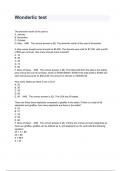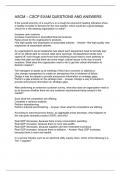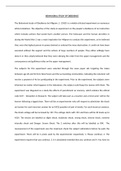Obtained> critical -> reject H0
Obtained increase -> less probable H0 -> lower p-value
Week 1 Web lecture
Statistics
• Univariate: measure one property from a person (e.g. What was the average grade of
the ISA exam last year?)
• Bivariate: take two properties and do relationship from one and another (e.g. Did
males and females differ in their grades?)
• multivariate: different variable related to different variable (e.g. Was the grade
dependent on initial motivation, the time spent on reading and gender?)
• The study of how we describe and make inferences from data (Sirkin)
• An inference is “a conclusion reached on the basis of evidence and reasoning.”
• Distinction between descriptive & inferential statistics
• Descriptive: measurement do on the sample, describing the data
• Inferential: taking a sample of the population and make a larger statement of the
whole population
Units of analysis & variables
• Unit of analysis: “the what or who that is being studied e.g. individual, families,
countries, companies
• Variable: a measured property of each of the units of analysis e.g. Age, household
income annual revenue
Level of measurement
• Nominal: group classification, no meaningful ranking possible, numerical coding
arbitrary
• Ordinal: meaningful ranking, unknown distance between categories
• Interval: meaningful ranking with equal distance e.g. marks from 0-10, 0 doesn’t
mean the absence
• Ratio: meaningful ranking with equal distance, absolute and meaningful zero point
e.g. age 0 = no age, 0 means absense
• ****for likert scale, can treat it as interval (1=not addicted at all ,10= heavily
addicted)
Unit of analysis and continuous or discrete variable
• A continuous variable is measured along a continuum, whereas a discrete variable is
measured in whole units or categories.” (Privitera)
, • Continuous: numbers can have decimal points e.g. a person’s heigh, surface area of a
country, average of children per woman in a country (UoA: country not woman as
they are comparing between different countries)
• Discrete: whole integer e.g. a person’s no of children, no of doctors in country (UoA:
country)
Measures of central tendency
• To univariately describe the distribution of variables on different levels of
measurement
1. Mean (interval/ratio variables)
• = all values are added up and divided by n, i.e. the number of observations in
the sample
• most useful for describing (more or less) normally distributed variable
• M (alternative notation: x)
• Questions like “what is the average trust in the news media in this sample”
åx 4 + 5 + 2 + 4 + 3 + 5 + 5 + 6 + 10 + 6
M = M= =5
• n 10
µ= å
x
• Population mean : N
• Some characteristics of mean:
o Changing any score will change mean
o Adding or removing a score will change mean (unless that score is already
equal to mean)
o Adding, subtracting, multiplying, dividing each score by a given value
causes the mean to change accordingly
o Sum of differences from the mean is zero: data-mean
å(x - M ) = 0
bb’s explanation:
Sum of all data=mean x number of data
For example 1,2,3,4,5 Mean=3
Sum of difference: (1-3)+(2-3)+(3-3)+(4-3)+(5-3)
Can rearrange as 1+2+3+4+5-3-3-3-3-3
=sum of all data- mean x number of data
=0
, o Sum of squared differences from the mean is minimal : (data-mean)²
➢ larger sum of square means that scores deviate more from the mean
➢ minimal: if we use other value other than the mean to calculate SS ->
>minimal
2. Median (ordinal & interval/ratio variables)
• = the value of the “middle case“
• Can be used for ordinal & interval/ratio variables that have skewed
distributions
In frequency tables in SPSS: first identiy the first category that exceed 50% in
the ‘cumulative percent’ column
3. Mode (Nominal & ordinal & interval/ratio variables)
• = the mode is the category with the largest amount of cases
• In frequency tables in SPSS: first identiy the first category that exceed 50% in
the ‘cumulative percent’ column
Measures of Central Tendency and normal/skewed distributions
Practical SPSS stuff
-Group size: included
-Specific variable’s data: Data > select cases







